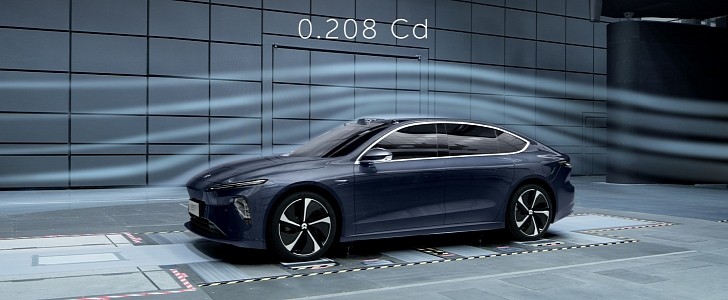NIO seems to be pretty proud of its first sedan. The ET7 obtained a remarkably low drag coefficient: only 0.208. NIO said it is the second-lowest result for production vehicles, but it failed to inform which one is the best: the Mercedes-Benz EQS, with a 0.20 drag coefficient. The ET7 ties with the Tesla Model S Plaid and beats the Lucid Air’s 0.21 cx. However, what really caught our attention in the pictures released by the Chinese company were the LiDAR and high-definition cameras the electric sedan will present.
Called Watchtower sensor layout, it puts the LiDAR in the center of the upper extreme of the windshield, with an 8-megapixel high-resolution camera on each side. NIO said its aerodynamics team had a lot of work to ensure these sensors would not hurt the car’s efficiency in that matter. What was inevitable was spoiling the aesthetics. The LiDAR and the two cameras look like horns depending on how you look at the ET7.
NIO was aware of that when it said, in its press release, that the need for such sensors “redefines the exterior design in the autonomous driving era.” The euphemism is just to warn those who are not willing to drive their cars themselves will have to make do with the “horns” and praise the technology instead. Many will just pass on the autonomous driving promises to have a better-looking car.
To achieve the low aerodynamic drag, NIO would have made “over 800 CFD simulation cases and 120 hours of wind tunnel testing.” The company informs that this process allowed it to optimize 13 areas of the car design. However, those are not the only solutions NIO adopted to make the air flow along the ET7 body instead of fighting against it.
The ET7 has an AGS (active frill shutter) that closes the air intake when it is not necessary. It also has a standard air suspension that lowers the vehicle at higher speeds, reducing its frontal area. For the air that goes underneath the body, a lightweight underbody coverage would also help cut air drag.
That aerodynamic profile will help the ET7 become one of the most energy-efficient vehicles NIO ever sold. When it receives the 150-kWh solid-state battery pack the company promised for 2022, it would have a range of more than 1,000 kilometers (621 miles), probably under the NEDC cycle. When converted to WLTP or EPA cycles, the numbers are lower.
NIO was aware of that when it said, in its press release, that the need for such sensors “redefines the exterior design in the autonomous driving era.” The euphemism is just to warn those who are not willing to drive their cars themselves will have to make do with the “horns” and praise the technology instead. Many will just pass on the autonomous driving promises to have a better-looking car.
To achieve the low aerodynamic drag, NIO would have made “over 800 CFD simulation cases and 120 hours of wind tunnel testing.” The company informs that this process allowed it to optimize 13 areas of the car design. However, those are not the only solutions NIO adopted to make the air flow along the ET7 body instead of fighting against it.
The ET7 has an AGS (active frill shutter) that closes the air intake when it is not necessary. It also has a standard air suspension that lowers the vehicle at higher speeds, reducing its frontal area. For the air that goes underneath the body, a lightweight underbody coverage would also help cut air drag.
That aerodynamic profile will help the ET7 become one of the most energy-efficient vehicles NIO ever sold. When it receives the 150-kWh solid-state battery pack the company promised for 2022, it would have a range of more than 1,000 kilometers (621 miles), probably under the NEDC cycle. When converted to WLTP or EPA cycles, the numbers are lower.







